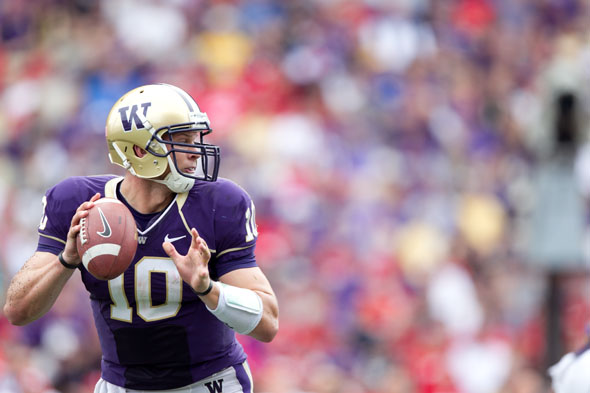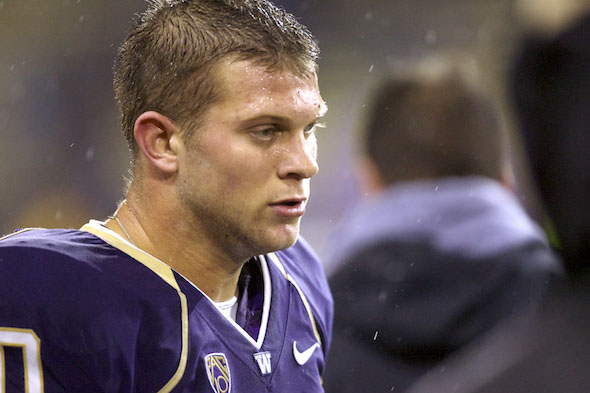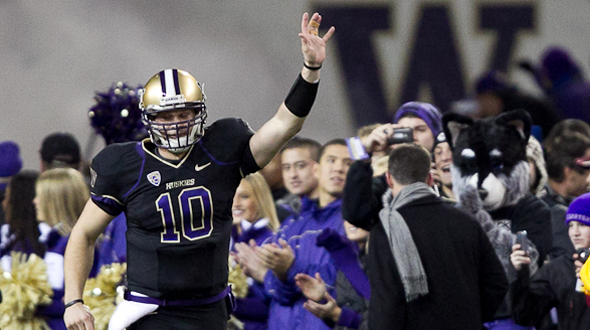
SAN DIEGO — Picture Jake Locker. What do you see?
The hometown quarterback that has helped drag the Huskies out of the muck and into a bowl?
An over-hyped, over-throwing, fifth-year senior who didn’t live up to expectations?
Are you a mother whose ailing child was befriended by Locker?
A clear-headed draft scout questioning Locker’s understanding of defenses?
Who you are determines who he is.
If you’re the University of Washington, he has been a tool to do the heavy lifting during the recent pursuit of redemption. An accommodating star attraction who would rather spend time with his pals and dog than in front of a camera. But the school put him on the sides of buses, draped his No. 10 over store mannequins. Sent him to New York, had a Heisman Trophy campaign in place.
If you’re a Huskies fan, Locker left his hometown of Ferndale to rescue the wobbling program. The thrill spurred by his enrollment evolved often into grousing, especially this year, when he was less than expected.
Locker’s five years have elapsed. He made it to a bowl game. Sat and watched most of an 0-12 season. He’s endured bipolar coaching philosophies. Thrown crushing red zone interceptions. Arced Apple Cup-winning throws.
Now, it’s about over and Locker has become an unwitting enigma. His overwhelming physical ability and Johnny Positive attitude put him in an untenable position. If he didn’t walk across Lake Washington, it wasn’t enough.

LOCKER ALWAYS CONTENDED HE returned because he did not want to have regrets. It’s difficult to quantify whether regret will come from doing or not doing. Typically, it’s the latter.
He chose to stay, to do. His 2010 performance will cost him millions of immediate dollars. In the long run, he may be able to recoup that money. Regardless, he contends it’s of minimal concern.
The 2,209 passing yards, 302 rushing yards, 56.6 percent completion rate, 22 total touchdowns and nine interceptions were enough for him to be named a “Most disappointing player in the country” candidate by an ESPN Pac-10 blogger. In his final season, a player who never beckoned hype had his football reputation in many ways damaged by it.
The school launched its self-serving Heisman campaign to begin the season. That was more about brand development than direct benefit for Locker, knowing it was an unattainable goal for the quarterback of this team, according to history. Not because of his skill set, but because no quarterback in the modern era has won the Heisman without his team winning nine or more games. There was not a pundit in America who thought Washington would go 9-3 or better, yet illogically Heisman expectations applied to Locker despite his not-ready team.
Steve Sarkisian specified preseason numbers of hope: A 3-to-1 touchdown-to-interception ratio. A 65 to 68 percent completion rate. Those, unlike the Heisman, appeared attainable. The premise for all anticipation was the smoothing and prospering of Locker as a passer in 2009. His first season with Sarkisian and quarterbacks coach Doug Nussmeier reworked Locker’s hands, hips and feet.
The assessment of 2010 is that he regressed. Locker’s completion percentage dipped from 58.2 to this year’s 56.6. His touchdown-to-interception ratio held at 1.9-1. The 4-for-20 fiasco against Nebraska was enough for one Huskies fan to inform another, post-game, that he should burn the No. 10 jersey on his back.
More important, it left questions for NFL people.
“He had made so much progress in year one under Steve Sarkisian, that I and certainly every NFL scout I’ve spoken to, believed that Locker would make similar gains in year two under Sarkisian and that hasn’t happened,” Rob Rang, senior draft analyst for CBSsports.com, said.
Rang’s preseason beliefs remain 12 games later. Locker’s accuracy to all levels of the field and ability to read defenses are in question. His physical ability, leadership, arm strength, and toughness are not. The prevailing question will be the one most necessary for teams considering Locker in the draft: Are the problems ones that can’t be fixed or are yet to be?
“That’s literally about a $50 million question,” Rang said.
Thumb through Washington’s record book and Locker’s name is in type swollen for distinction to show a current player influencing history. His 53 touchdown passes are second all-time to Cody Pickett’s 55. He is second in passing yards and attempts. Locker leads Washington quarterbacks in career rushing touchdowns and rushing yards. He is fourth all-time in rushing touchdowns, including running backs. He’s fifth all-time in interceptions.
Yes, he has been at Washington for five years. Though thoughts that follow the phrase “fifth-year senior” are not in line with actual games played. Locker has been on the field for just more than three full seasons.
Any defogged assessment of Locker needs to take that into account. He has played 38 career games. A thumb injury midway through the second quarter of the fourth game ended his 2008 season. Yet at times he is inexplicably viewed as responsible for 0-12. During those 38, he scored 81 touchdowns. The team scored 121. What little or moderate success the woebegone team had, came from Locker.
The lack of wins is a criticism of many. Locker is 14-24 as Washington’s starter and supposed savior. But not all Huskies teams are built equal.
Since 1975, Steve Pelluer’s 28 are the most wins by a Washington quarterback. Brock Huard had 25, Chris Chandler 22. Comparing team talent from other eras to now is comparing bazookas to oranges.
As Sportspress Northwest research shows in this post by Steve Rudman elsewhere in Pressing the Point, Chandler played with 18 NFL draft picks and 10 first-team, All-Pac-10 selections. Sixteen pros and 11 first-teamers shared the sideline with Pelluer. Fifteen of each ran with Huard.
Locker? Two draft picks: linebacker Donald Butler and defensive end Daniel Te’o-Nesheim in 2009. A likely third will come in the 2011 draft when linebacker Mason Foster is selected. Foster is the only Pac-10 first-teamer to be a Husky with Locker. That leaves the draft people wondering.
“It is disconcerting that he hasn’t developed more consistency by now,” Rang said. “But at the same time when you take into account the level of talent surrounding him, especially on the offensive line, then that’s one of the reasons you take it with a grain of salt. You understand that’s maybe why he has not made the progress.”
The belief by many is Locker’s moment of truth will come against Nebraska in the Holiday Bowl. Not for Rang. He’s waiting to look at Locker while the quarterback is surrounded by talent at the Senior Bowl in Mobile, Ala., on Jan. 29, 2011.
“I believe that Jake Locker five years from now is going to be a very successful, winning, starting NFL quarterback,” Rang said. “But, at the same time, those first couple of years are going to be tough and I didn’t necessarily believe that was going to be the case heading into this season.
“I thought Jake was going to continue to make some progress and it just hasn’t happened yet. That doesn’t mean he can’t and that’s what’s frustrating about him.”

A SUMMARY OF LOCKER’S time at Washington would be incomplete without talking about Kyle.
When Kyle Roger was born in 2001, his aunt, Melissa Willhite, held him and sang “Bow Down to Washington.” When Locker committed to Washington, Aunt Melissa purchased purple No. 10 jerseys for Kyle and his older brother, Nicolas. The family knew Locker was No. 10 at Ferndale High School and took a chance.
Kyle’s mom, Christin, was enrolled at Washington from 1989-92 and witnessed football glory. Her grandmother played golf for Washington in the 1920s and her father attended the school. Christin and crew had football season tickets since.
Bad news came to the Rogers in 2007. Kyle, 6, was diagnosed with a rare brain stem tumor. A spirited, blond-haired boy, he was now in the care of Seattle Children’s Hospital but received radiation treatment at the UW Medical Center. A meeting between Locker and Kyle was brokered. Christin anticipated Locker would spend five minutes greeting her sons, then move on.
Several hours passed and Locker and Kyle were still at it. They migrated from the initial meeting spot outside of Husky Stadium down to the field. They threw the ball and practiced field goals. Locker brought Kyle and Nicolas into tunnel to teach them how to bark mean. Problem was, giggling overpowered the attempted menace.
That day, Locker began one of his enduring UW relationships. Kyle showed Locker where his seats were, and Locker promised to point when he scored his first touchdown. After Locker crossed the goal line with 2:48 remaining in the second quarter of the 2007 opener against Syracuse, up went his right index finger in Kyle’s direction. Locker called post-game to be sure Kyle noticed.
As their relationship grew, Kyle’s health worsened. Locker would visit Children’s Hospital and play video games against Kyle while the family waited for test results, or while Kyle was between multiple appointments. The majority of their showdowns came while playing “Mario Kart.” Kyle was losing his health, but not his savvy, knowing he had a shot at victory when this was the game of choice.
When the meeting was not at a medical facility, the pair went for ice cream or met at the stadium. Their final excursion was at the Baskin-Robbins in the U District in 2009. There would be no more running, woofing or field goals.
Kyle, now 8, was in a wheelchair. He could not walk, hear or speak. For some time, he communicated through black marker on a whiteboard. At this point, swallowing was also difficult, making the genial consumption of ice cream a challenge.
When Kyle found out they were going to see Locker, he worried how he would look.
“Kyle didn’t want to go because he didn’t want Jake to see him the way he was,” Christin said. “I think he thought it would make a difference somehow.”
It had for others. As Kyle’s tumor began to win, people at times had a hard time being around him. Not Locker.
Kyle insisted on ditching his wheelchair. Christin held him by his armpits on the way into the store as he attempted to use his legs for the first time in weeks.
Locker held Kyle up for around an hour and a half. Kyle teased Locker via whiteboard salvos while downing his double scoop of cookies and cream and rainbow sherbet. He also finished off Locker’s mint chocolate milkshake.
“For me, that was the time that really epitomized how much Kyle meant to Jake,” Christin said. “Within a few minutes, Kyle realized it wasn’t really what he looked like on the outside, it was how he looked on the inside.
“It may not be anything that stood out to (Locker) the way it did to a mom sitting there watching.”
Kyle died three weeks later.
Since, Locker has used the media to promote the Run of Hope, a fundraiser for pediatric brain tumor research. About six hours after arriving home from stunning USC in early October, Locker was in a hat and jeans under a white tarp at Seattle’s Seward Park. A hand-written sign, Jake Locker for Run of Hope, hung over his head.
The Sunday after the Nebraska debacle, Locker was on live TV talking up the race despite being freed of his obligation by Christin and the sports anchor.
Locker maintained his relationship with Nicholas and the Roger family. Christin remains thankful for the time Locker spent, despite seeming to have little available. After getting to know him, she says continuation of the relationship is no surprise.
“He’s not obligated to do it,” Christin said. “It’s sad that it’s surprising. The only reason it’s surprising is that more people don’t do that.”
IF LOCKER STARTED AS a block of granite, he ends as an unfinished sculpture. Still pure and powerful, Locker leaves Washington with rough edges remaining.
He’s a 6-4, 240-pound conundrum who was escalated by hope to the point that results short of perfection at times produced disgust. Yet he also received the biggest backing from the crowd.
Scouts are not sure who he is. Washington fans are often sure, though their certainty is split. Teammates know.
“Jake’s the face of our program,” linebacker Cort Dennison said. “Everybody sees the nice, sweet Jake. He’s always smiling. Obviously, he’s a great kid.
“A lot of times people don’t see that toughness that he has and that competitive nature that he has. When you ring his bell or press that wrong button, a different side of Jake is going to come out. It’s a side that a lot of teams probably don’t want to see. I hate when it happens in practice.”
He’s been over-hyped yet under-valued, a seemingly impossible juxtaposition pervasive through Locker’s five years. No other quarterback in Washington history arrived with such expectation. No other leaves with such numbers.
When avoiding incineration, Locker’s No. 10 jerseys spread throughout the Sound are indicative of the fervor he has provided a program in despair. When he played, Locker was always the “if he …” part of the pre-game conversation. Post-game, he was often the simple explanation by opposing coaches for why their team lost.
In a drizzle last Monday, Locker practiced in Husky Stadium for the final time. His last practice throw led to a discussion with Nussmeier. They went over snatching the football into a throwing position, and Nussmeier spread his feet, then slapped his thigh to express what needed to be adjusted. It was on-going mechanical work.
The skies, murky at the start of practice, opened. Late in the practice it poured. Everyone came out of the storm and into the tunnel entrance.
It was better, not perfect. Shelter from the storm was found. Locker and the rest had to stand in a puddle to receive it.
